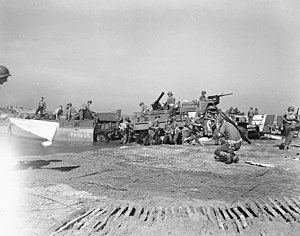Operation Avalanche
| Invasion of Italy | |||||||
|---|---|---|---|---|---|---|---|
| Part of the Italian Campaign of World War II | |||||||
 Troops and vehicles being landed under shell fire during the invasion of mainland Italy at Salerno, September 1943. |
|||||||
|
|||||||
| Belligerents | |||||||
|
|
(to 8 September) |
||||||
| Commanders and leaders | |||||||
|
|
|
||||||
| Strength | |||||||
| 189,000 (by 16 September) | 100,000 | ||||||
| Casualties and losses | |||||||
| 2,009 killed 7,050 wounded 3,501 missing |
3,500 casualties (incl 630 killed) |
||||||
The Allied invasion of Italy was the Allied amphibious landing on mainland Italy that took place on 3 September 1943 during the early stages of the Italian Campaign of World War II. The operation was undertaken by General Sir Harold Alexander's 15th Army Group (comprising Lieutenant General Mark Clark's U.S. Fifth Army and General Bernard Montgomery's British Eighth Army) and followed the successful invasion of Sicily. The main invasion force landed around Salerno on 9 September on the western coast in Operation Avalanche, while two supporting operations took place in Calabria (Operation Baytown) and Taranto (Operation Slapstick).
Following the defeat of the Axis Powers in North Africa in May 1943, there was disagreement between the Allies as to what the next step should be. The British Prime Minister, Winston Churchill, in particular wanted to invade Italy, which in November 1942 he called "the soft underbelly of the axis" (and General Mark W. Clark, in contrast, later called "one tough gut"). Popular support in Italy for the war was declining, and he believed an invasion would remove Italy, and thus the influence of Axis forces in the Mediterranean Sea, opening it to Allied traffic. This would reduce the amount of shipping capacity needed to supply Allied forces in the Middle East and Far East at a time when the disposal of Allied shipping capacity was in crisis and increase British and American supplies to the Soviet Union. In addition, it would tie down German forces. Joseph Stalin, the Premier of the Soviet Union, had been pressing Churchill and Roosevelt to open a "second front" in Europe, which would lessen the German Army's focus on the Eastern Front, where the bulk of its forces were fighting in the largest armed conflict in history against the Soviet Red Army.
...
Wikipedia
